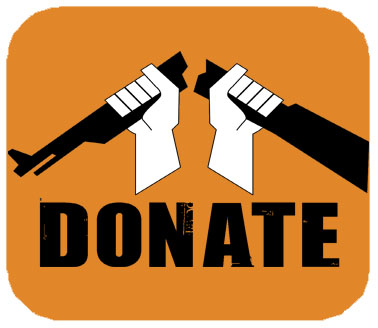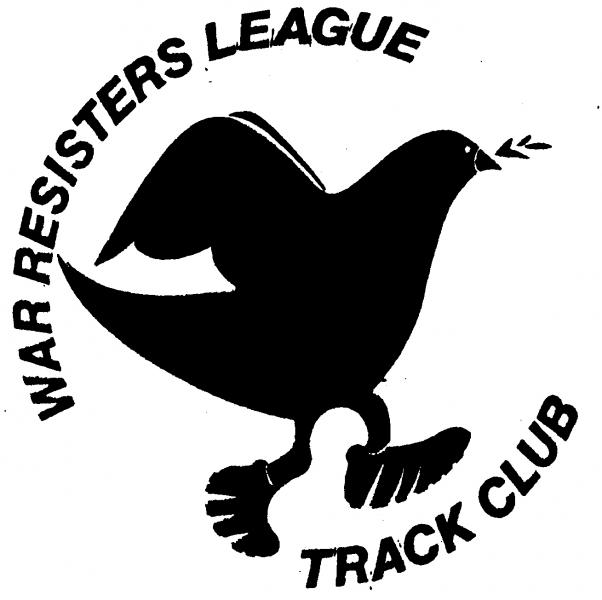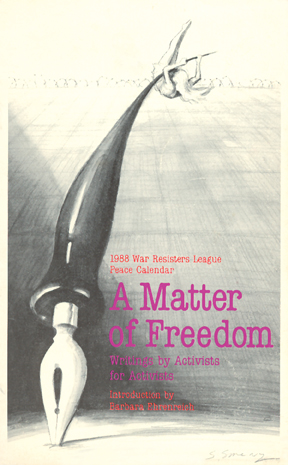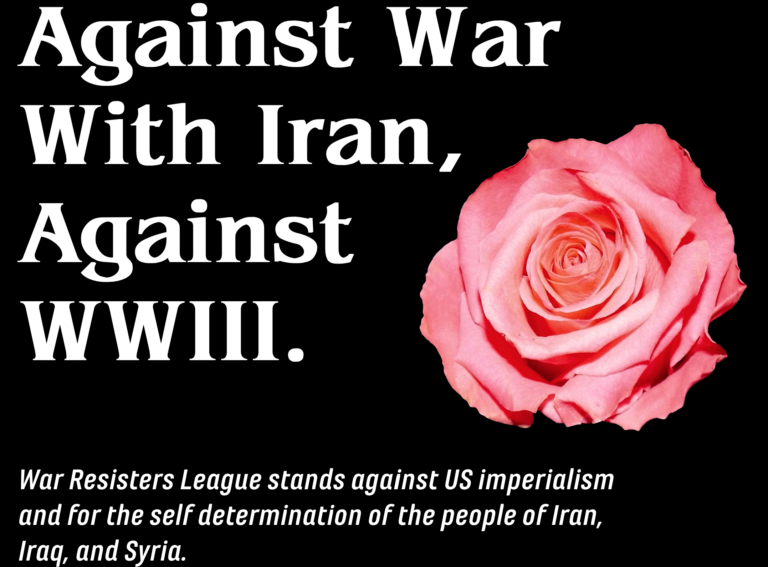Decades of Nonviolence Training
From The Nonviolent Activist, July – August 1998
Practicing Nonviolence
By Joanne Sheehan
The acquisition of the spirit of nonresistance is a matter of long training in … appreciation of the hidden forces within ourselves. It changes one’s outlook on life. — Mohandas Gandhi
We have to practice nonviolence before we can practice nonviolence. I have developed a deeper understanding of the philosophy and practice of nonviolence through nonviolence training.
I first learned campaign building and action planning at nonviolence training sessions as we—pacifists and antiwar activists—worked to stop the war in Vietnam. My commitment to nonviolence and feminism became woven together at a women’s nonviolence training weekend workshop. I have prepared for civil disobedience actions at such trainings—and practiced how to practice nonviolence in my daily life.
In 1971 I attended my first nonviolence training, a weekend workshop sponsored by the Quaker Project on Community Conflict in New York City. Quaker Project regularly held weekend training sessions where participants learned about the philosophy of nonviolence, developed actions through strategy games and exercises and prepared for action through discussion and role-plays. Some weekends focused more on preparation for a certain action; others brought us through the process of planning and preparing grassroots actions.
My first women-only event was another training weekend the same year, organized by the Quaker Project women trainers S.J. Avery and Kathy Feuer. Some two dozen women came together to discuss the connections and tensions between nonviolence and feminism, to share stories and to learn through videotaping and role-playing how to defend ourselves nonviolently. During the weekend, we women had the chance to define what we needed from nonviolence training. We discovered that, instead of seeing ourselves as aggressive people who needed to learn to be nonviolent—the unspoken underlying assumption of much training—we felt that as women we were often too passive. We needed to learn to be assertive in order to be nonviolent. This insight allowed us to develop a different approach in nonviolence training: helping people move to assertive nonviolence, rather than making them choose between the old dichotomies of passivity and aggressiveness.
Training for What?
“Nonviolence training” most commonly refers to preparation for an action, and trainers believe that it is most successful when preparing for a real situation. But it can also be an opportunity to introduce people to nonviolence as a philosophy, lifestyle and tactic. Nonviolence training can strengthen a group, developing community spirit while people learn to work better together to build a stronger movement. In trainings we gain insight into our responses to conflict and learn nonviolent options. Techniques used by nonviolence trainers include exercises such as brainstorms, role-plays, working in small groups, strategy games, etc.
The use of the word “training” has long been debated. As Theodore Olson and Lynne Shivers explain in their 1970 pamphlet, Training for Nonviolent Action, “For many, the word training brings to mind the parade ground rituals of the army or tedious calisthenic exercises. For others, it conjures up the picture of the ‘human relations expert’ whose craft it is to manipulate trainees’ minds until they are ‘adjusted’ to the needs of those who employ these experts.”
Some prefer to use the term “preparation for action,” but nonviolence training means much more than preparation for civil disobedience. Longtime trainer Grace Hedemann describes it in the WRL Organizer’s Manual as “part of a teaching process” that “prepares people in planning and organizing for nonviolent social and structural change … [and] begins the process of unlearning much about the attitude and behaviors taught in general society.”
Satyagraha to Resurrection City
By 1936, Mohandas Gandhi had recognized the importance of training for participation in satyagraha—“soul force”—campaigns. His initial trainings consisted of talks on the meaning and discipline of nonviolence, to which he later added a day of fasting for self- purification. The trainings emphasized nonviolent discipline and development of skills such as crowd control and included prayer, yoga and constructive program work such as spinning. Gandhi insisted that those who take part in civil disobedience accept nonviolence as a philosophy, not simply as a tactic for action. He feared that those who did not truly believe in nonviolence would be tempted when faced with violence to retaliate in kind. In 1942, radical pacifists A.J. Muste, James Farmer and John Swomley formed the Nonviolent Action Committee of the Fellowship of Reconciliation, which trained teams to provide leadership in antiracist and antimilitarist work. Out of that committee grew the Congress of Racial Equality, which in 1945 became the first organization to develop nonviolence trainings in preparation for involvement in the civil rights movement.
According to trainer-historian Charles Walker, “[War resisters] George Houser and Bayard Rustin began a series of workshops that foreshadowed methods used in today’s training: role-playing, sociodrama, group decision-making, and action as the training milieu.” (Training for Nonviolent Action: Some History, Analysis, Reports of Surveys, Center for Nonviolent Conflict Resolution, Haverford College, PA, 1972.) For 10 years beginning in 1947, CORE ran month-long training workshops in Washington, DC. Participants learned theories and skills in nonviolence and organizing, with the goal of breaking segregation in the capital area. By the time the CORE workshops ceased, the pacifist resistance community Peacemakers was holding “Orientation Programs in Nonviolence” across the country, which they continued through the early 1970s.
Early in the civil rights movement, the Southern Christian Leadership Conference based its preparation for nonviolent action campaigns such as the 1956 Montgomery Bus Boycott on African- American religious traditions. At mass meetings held in local churches, Martin Luther King, Jr. and others lectured on nonviolence. Community spirit and the nonviolent discipline were strengthened through singing and prayer. As civil disobedience became a crucial part of the civil rights movement, training was developed that included role-plays and the signing of a pledge to remain nonviolent. Peace and civil rights activists, who shared common philosophical roots, trainers and techniques, worked together.
Barbara Deming, who would become the country’s preeminent theorist of feminism and nonviolence, was introduced to training and direct action in the summer of 1960. On the back cover of a borrowed copy of Liberation magazine, Deming read about a 16-day training program in nonviolent methods scheduled to take place in New London, CT, where the militant pacifist Committee for Nonviolent Action was preparing for a campaign against the production of Polaris submarines. Later that year, she described the experience in her book, Revolution and Equilibrium. “When I first learned about it through chance, I decided to attend for perhaps a day,” she wrote. Instead, she spent the whole 16 days with those who were “experimenting with nonviolence.”
Then, in 1962, the Student Nonviolent Coordinating Committee and the New York Society of Friends organized the meeting they called the Nyack Consultation on Training for Nonviolent Action. Twenty-five peace and civil rights activists planned extensive training programs in the first such gathering on nonviolence training the nation had seen.
It would take such extensive trainings to prepare civil rights workers for the violence they would encounter in the South. Participants in the Mississippi Freedom Summer of 1964 began with a two-week training in Ohio. The book A Manual for Direct Action by Martin Oppenheimer and noted trainer George Lakey was written for that workshop. (I was in high school at the time and saw pictures in Life Magazine of college students doing role-plays during the trainings.) The Poor People’s Campaign of 1968 held training programs for marchers, marshals and support people, and a “training tent” at Resurrection City—the “city” of tents on the Washington Mall—featured training workshops.
The Vietnam War
As the movement against the war in Vietnam grew, training took on a different form. “Marshals” were trained for large demonstrations, but generally training was not made available to the rest of the participants. The role of nonviolence trainer became separate from what had been the dual role of organizer and trainer. Training centers formed in the late 1960s and early 1970s provided weekend-long to year-long trainings and education in nonviolence, skills-building in campaign and strategy development and training for trainers. Techniques, games and resources were developed by those training centers and collectives, which included the Chicago Nonviolent Training Center, California’s Institute for the Study of Nonviolence, the Quaker Project on Community Conflict in New York City, the Martin Luther King Jr. School of Social Change in Chester, PA, and the Movement for a New Society in Philadelphia.
WRL first became formally involved in nonviolence trainings during the early 1970s. Trainers and organizers worked closely together for the antiwar actions in the spring of 1971 that culminated in the Washington May Day actions. WRL staffer Jerry Coffin wrote the Mayday Tactical Manual, and trainers Carl Zietlow (who taught me the basics of training) and Brian Jaffee wrote the Training Manual for Nonviolent Direct Action for the spring actions. Training centers were set up in Washington a month before May Day. During the two weeks of action in Washington, nearly 15,000 people were arrested.
The Birth of Affinity Groups
In 1976 the Clamshell Alliance developed a different approach as they organized people to take part in the occupation of the Seabrook nuclear power plant site in New Hampshire. All Seabrook occupiers were required to participate in nonviolence training, agree to a set of nonviolence guidelines and become part of an affinity group for the action. (An affinity group, often formed during training sessions, is a self-sufficient support system of five to 15 people who act together and form the basic decision- making body of mass actions.) None of those elements were new to social change movements, but the blending of them with a commitment to consensus decision-making and a non-hierarchical structure was new.
The trainings (or nonviolence preparation sessions, as they were also called) were the key to making the style and process work. Clamshell Alliance made the affinity group the cornerstone of the action, creating a support system for every participant and reducing or eliminating feelings of isolation in a crowd. The New England American Friends Service Committee—particularly staff people Sukie Rice and Jane Guise—helped develop the first trainings for Clamshell. Nonviolence training began six months before the Seabrook occupation. Initial sessions took place over a weekend, and people formed affinity groups and became part of the decision-making process for the action. As the action grew closer, the length of trainings became shorter. Nonviolence trainers from WRL, Movement for a New Society and others organized training for participants and training for trainers. People who had worked with Peacemakers and CNVA provided not only skills but an important sense of history and insight gained from years of nonviolent actions. I remember a training for trainers where Wally Nelson, tax-resister and a founder of Peacemakers, told us stories of civil rights actions and taught us how to curl into a fetal position if dogs were used against us.
Seabrook became the model for civil disobedience actions against nuclear power and weapons. The Seabrook occupation made nonviolent civil disobedience a more available option for the grassroots movements by providing a new model of training and participation. A new generation of nonviolent activists and nonviolence trainers was being born.
War Resisters League further developed nonviolence training, playing a significant role in promoting this new style of organizing, training and action. Beverly Woodward, who had been WRL’s representative to War Resisters International for many years, organized the International Seminars on Training for Nonviolent Action in the mid-1970s. These gatherings brought together trainers from around the world. In 1977, I participated in a three-week International Seminar in Mexico with 76 other trainers from 30 countries; it was there I began the important process of learning about nonviolence training from people in other cultures. Discussions at those seminars gave rise to major efforts such as the World Information Service on Energy (WISE made popular the logo of the sun with “Atomic power? No thanks,” which was used in many languages worldwide) and Peace Brigades International.
While some other trainers emphasized group process, WRL worked to strengthen the understanding of nonviolence as fundamental to the action. WRL trainings included issues of oppression—sexism, classism, racism and homophobia—and emphasized the need for six- to eight-hour nonviolence trainings rather than two- to four-hour preparation sessions that only addressed group process and logistics. The League’s commitment to nonviolence and nonviolent action, and the fact that its staff and activists were both organizers and trainers, strengthened WRL’s ability to make an impact on the social change movements of the late 1970s and 1980s.
Carrying the model forward, WRL organized trainings and civil disobedience at national demonstrations such as those at the U.N. Special Sessions on Disarmament of 1978 and ’82, the Wall Street action of 1979 and the 1980 March from the Department of Energy to Blockade the Pentagon. Several WRL staffers of the period—notably Ed Hedemann, Grace Hedemann and Susan Pines—worked as both organizers and trainers. WRL women were involved in the Women’s Pentagon Actions of 1980 and 1981 and the Seneca Peace Encampment in upstate New York in the early 1980s. WRL activists including Esther Pank helped organize grassroots efforts like the Long Island SHAD Alliance, which prevented the Shoreham nuclear plant from opening, and the protests against production of Trident and other submarines in Groton, CT, where I was both an organizer and a trainer. The League also organized trainings for thousands of other activists as well as trainings for new trainers and worked on handbooks for these coalition efforts. At least in the Northeastern United States, WRL became a recognized resource for training and a “home base” for many trainers. The first project of the New England WRL office in 1985 was to create a nonviolence trainers network.
In 1989, WRL co-produced the Handbook for Nonviolent Action as a resource for grassroots groups. As co-publisher Kate Donnelly wrote in the introduction, “This handbook continues a tradition of sharing and passing on beliefs, strategies, values and tactics. It offers the combined experience and wisdom of many people who have struggled to make the world more just.” (The League’s 1990 Directory of Resource People for Nonviolence Training is now somewhat out of date, although still useful.)
Today and Tomorrow
Unfortunately, it’s not possible to cover in this space the whole story of nonviolence training. I’ve had to omit many chapters, like the accounts of organizing for actions in the U.S. West, at places like the Nevada Test Sites and Livermore Labs and Diablo Canyon in California, and the work of Quaker groups and individuals like Berit and George Lakey and Lillian and George Willoughby.
Nonviolence training continued to be used in preparation for civil disobedience in the1980s in the movements against intervention in Central America and the renewed activism of the lesbian and gay community. The most moving training I ever did was for the lesbian and gay action at the U.S. Supreme Court in October of 1987; shortly before the action, I facilitated a half-day training of mostly gay men—many of whom were HIV positive—and lesbians preparing for their first civil disobedience action.
But as civil disobedience became more popular, many activists accepted nonviolence simply as a tactic, and trainings lost their focus on its moral strength. Some groups boiled the nonviolence principles down to simple guidelines for each action. By the end of the ’80s, nonviolence trainings and actions in the United States appeared to have peaked. While nonviolent people’s power toppled regimes around the world, there were fewer and fewer nonviolent actions in this country.
Barbara Deming had asked in 1960, “One constant question, of course, recurring in all the discussions, was how the nonviolent method could gain mass support.” By 1990, the question seemed more relevant than ever. This year, as WRL and other groups organize for “A Day Without the Pentagon” in October (see articles, pages 8 and 9), we are finding that the infrastructure of nonviolence trainers needs to be revived. I hope this history helps inspire us to rebuild our resources for training.
To quote Deming one more time, “Nonviolence is an experiment, one that has just begun.” To develop that experiment, we need to come together, to share, to learn, to explore the possibilities nonviolence holds. Nonviolence training is a key to that exploration and the development of new nonviolent activists and activism.
Nonviolence trainer and organizer Joanne Sheehan is on the staff of WRL/New England and works with War Resisters International nonviolence trainers.
Share




